Family
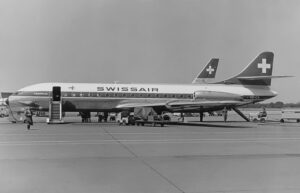 Fog delayed the departure of on September 4, 1963, but the delay was not able to save the plane or its passengers. Swissair Flight 306, a Sud Aviation SE-210 Caravelle III, named Schaffhausen, was scheduled to fly internationally from Zürich to Rome, with a stop in Geneva. Unfortunately, it crashed near Dürrenäsch, Aargau, shortly after take-off, killing all 80 people on board.
Fog delayed the departure of on September 4, 1963, but the delay was not able to save the plane or its passengers. Swissair Flight 306, a Sud Aviation SE-210 Caravelle III, named Schaffhausen, was scheduled to fly internationally from Zürich to Rome, with a stop in Geneva. Unfortunately, it crashed near Dürrenäsch, Aargau, shortly after take-off, killing all 80 people on board.
The plane was due to take off at 06:00 UTC, but the fog was throwing everything off. At 06:04 the flight was allowed to taxi to runway 34 behind an escorting vehicle, to await clearance. Then the crew of Swissair Flight 306, decided to taxi slowly down the runway at 06:05 to inspect the fog. Then they would return to the take off point. Part of the plan was to use high engine power in order to disperse the fog. It must have worked, because around 06:12 the Swissair Flight 306 returned to runway 34 and was allowed to take off. The flight took off at 6:13 and started to climb to flight level 150, which is about 15,000 feet, which would be its cruising altitude.
A short four minutes later, people on the ground witnessed a white trail of smoke coming from the left side of the aircraft. The white streak of smoke gave way to a long flame that erupted from the left wing. Around 06:20 the aircraft reached a height of about 8,900 feet. At that level, the plane began to descend and banking gently to the left before losing altitude more quickly and finally going into a steep and final dive. At 6:21 a frantic mayday message was issued. Then, at 6:22 the Swissair Flight 306 crashed into the ground on the outskirts of Dürrenäsch, approximately 22 miles from Zürich Airport.
So, what brought this plane down just minutes after takeoff. The taxi down the runway in an effort to clear the fog…believe it or not. When the plane went down the runway using full engine power, the pilot also applied the brakes so the plane wouldn’t try to take off. The brakes overheated, causing the magnesium wheels to burst. One of them burst on the runway prior to departure. Then, when the landing gear was retracted, the hydraulic lines in the gear bay were damaged, causing the hydraulic fluid to leak and ignite. The fire damaged the gear bay, and then the wing. Upon looking at the data from the airplane’s flight recorder, it was determined that the crew began experiencing difficulties at 6:18. The data became irregular beginning roughly two minutes later, 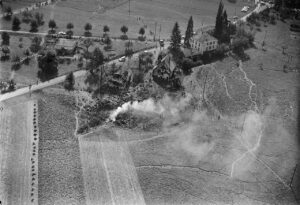 indicating that the fire was causing electrical problems. Analysis of the wreckage indicated that parts of the airplane began detaching “with increasing frequency” at about 6:18. The left engine had shut down prior to the crash, but it is uncertain whether this was from crew action, or a failure caused by the fire. The actual cause for the final loss of control was not conclusively determined, but it seems likely that loss of hydraulics played a key part in it. The rigidity of the left wing and rear fuselage, the integrity of the hydraulic flight control system, and the elevator control unit were all noted as possible areas the fire may have affected in the final portion of the flight to an extent which would have caused a rapid loss of control. In the end, all Caravelles were modified to use non-flammable hydraulic fluids, to avoid a recurrence of this tragedy.
indicating that the fire was causing electrical problems. Analysis of the wreckage indicated that parts of the airplane began detaching “with increasing frequency” at about 6:18. The left engine had shut down prior to the crash, but it is uncertain whether this was from crew action, or a failure caused by the fire. The actual cause for the final loss of control was not conclusively determined, but it seems likely that loss of hydraulics played a key part in it. The rigidity of the left wing and rear fuselage, the integrity of the hydraulic flight control system, and the elevator control unit were all noted as possible areas the fire may have affected in the final portion of the flight to an extent which would have caused a rapid loss of control. In the end, all Caravelles were modified to use non-flammable hydraulic fluids, to avoid a recurrence of this tragedy.

 My son-in-law, Kevin Petersen is a family-oriented guy who loves his kids and grandkids dearly. He and my daughter, Corrie Petersen have always been close to their kids. Like most parents, having a child move away is hard. When their son, Chris Petersen moved to Sheridan, Wyoming for college, it wasn’t that he had moved so far away, but rather that they could no longer see him every day. It’s never easy to have your child move away, and now with their son, Josh Petersen, his wife, Athena, and their sons, Justin and Axel (and their new son Cristian who is coming in January 2025) moving to Oklahoma, they are facing a new form of grief…that of being long-distance parents and grandparents. We all understand the move, but that doesn’t make it easy. Nevertheless, I know that Kevin and Corrie will find a way to make this work. Today’s technology will help some. They will call, facetime, video chat, text, and of course, visit…and it will be ok. Kevin and Corrie also have three grandchildren who still live here, and for that they are very grateful. Their son, Chris and his wife, Karen, have three kids, Cambree, Caysen, and Cyler.
My son-in-law, Kevin Petersen is a family-oriented guy who loves his kids and grandkids dearly. He and my daughter, Corrie Petersen have always been close to their kids. Like most parents, having a child move away is hard. When their son, Chris Petersen moved to Sheridan, Wyoming for college, it wasn’t that he had moved so far away, but rather that they could no longer see him every day. It’s never easy to have your child move away, and now with their son, Josh Petersen, his wife, Athena, and their sons, Justin and Axel (and their new son Cristian who is coming in January 2025) moving to Oklahoma, they are facing a new form of grief…that of being long-distance parents and grandparents. We all understand the move, but that doesn’t make it easy. Nevertheless, I know that Kevin and Corrie will find a way to make this work. Today’s technology will help some. They will call, facetime, video chat, text, and of course, visit…and it will be ok. Kevin and Corrie also have three grandchildren who still live here, and for that they are very grateful. Their son, Chris and his wife, Karen, have three kids, Cambree, Caysen, and Cyler. 

Kevin is an industrious guy, and he will also find ways to stay busy. He is currently working on his 1986 Chevy Monte Carlo right now, along with my husband, his father-in-law, Bob Schulenberg. They had to pull the engine out, finds the leaks it has, and repair them. For any who don’t know, pulling an engine is a huge job, and takes many hours. Nevertheless, these guys are experienced mechanics who have been doing this kind of work for years. When they get done with it, the Monte Carlo will be as good as new…the engine anyway. Kevin has done interior restoration and painting too, and it will eventually be showroom worthy.
Kevin is also very skilled at home renovation and has been making some changed to his and Corrie’s home. It isn’t done yet, but it really looks amazing. I have always been impressed with Kevin’s ability to restore, repair, renovate, and decorate the things they own. He really is an artist at heart, and his creativity is amazing. Kevin is also very creative in the kitchen. During Corrie’s time in nursing school, Kevin did all the cooking. He did 
 most of it before as well, because he is a trained chef, and very good at it. After Corrie had her gall bladder removed, meats because problematic for her, so she became a Lacto-ovo vegetarian, meaning she eats dairy and eggs, but not meats. Kevin embraced that in his cooking for her, even though he still eats meats. The meals he made were tasty, creative, and nutritious. He kept her going through those long school years, and continues to do so, not that she is a nurse. He has been a wonderful husband to our daughter, and we couldn’t ask for better. Today is Kevin’s birthday. Happy birthday Kevin!! Have a great day!! We love you!!
most of it before as well, because he is a trained chef, and very good at it. After Corrie had her gall bladder removed, meats because problematic for her, so she became a Lacto-ovo vegetarian, meaning she eats dairy and eggs, but not meats. Kevin embraced that in his cooking for her, even though he still eats meats. The meals he made were tasty, creative, and nutritious. He kept her going through those long school years, and continues to do so, not that she is a nurse. He has been a wonderful husband to our daughter, and we couldn’t ask for better. Today is Kevin’s birthday. Happy birthday Kevin!! Have a great day!! We love you!!
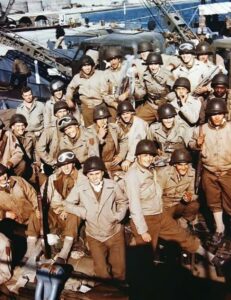
 Understandably, the size of the various armies has grown along with human civilization. It is estimated that nearly 28 million armed forces personnel stand at the ready globally in this present day, according to the London-based International Institute for Strategic Studies. Of course, peacetime armies would likely be smaller than wartime armies. World War II saw the most soldiers ever to be amassed…with about 70 million soldiers. Approximately 42 million of those soldiers were from the United States, the Soviet Union, Germany, and Japan. These nations armies and related services were four of the largest ever rallied to the battlefield. The largest three were the United States (12,209,000 troops in August 1945), the German Reich (12,070,000 troops in June 1944), and the Soviet Union (11,000,000 troops in June 1943). Those numbers are staggering to think about.
Understandably, the size of the various armies has grown along with human civilization. It is estimated that nearly 28 million armed forces personnel stand at the ready globally in this present day, according to the London-based International Institute for Strategic Studies. Of course, peacetime armies would likely be smaller than wartime armies. World War II saw the most soldiers ever to be amassed…with about 70 million soldiers. Approximately 42 million of those soldiers were from the United States, the Soviet Union, Germany, and Japan. These nations armies and related services were four of the largest ever rallied to the battlefield. The largest three were the United States (12,209,000 troops in August 1945), the German Reich (12,070,000 troops in June 1944), and the Soviet Union (11,000,000 troops in June 1943). Those numbers are staggering to think about.
As is expected in a world war, many soldiers are needed. So, the World War II army of the US became the biggest army in history. Citizens of the United States are notorious for patriotism, when we have been attacked. It is like waking a sleeping giant, and we will retaliate with a vengeance. Due in part to that surge of American patriotism and also because of conscription (the state-mandated enlistment of people in a national service, 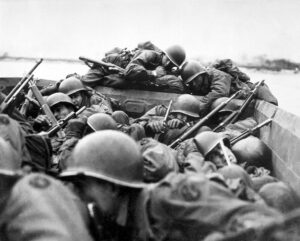
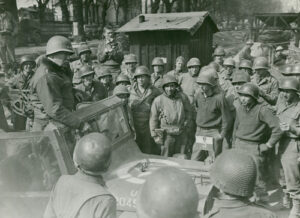 mainly a military service), the US Army numbered 12,209,000 soldiers by the end of the war in 1945. It is little surprise that the Japanese found themselves surrendering to the United States on this day, September 2, 1945. of course, the use of the atomic bombs on Hiroshima and Nagasaki, left little doubt that the Americans not only had the atomic bomb, but we would us it. Basically, their choices were to stay in the fight and die or surrender. They chose the latter, and the rest is history.
mainly a military service), the US Army numbered 12,209,000 soldiers by the end of the war in 1945. It is little surprise that the Japanese found themselves surrendering to the United States on this day, September 2, 1945. of course, the use of the atomic bombs on Hiroshima and Nagasaki, left little doubt that the Americans not only had the atomic bomb, but we would us it. Basically, their choices were to stay in the fight and die or surrender. They chose the latter, and the rest is history.
In order to determine which of the armies were the largest in history, 24/7 Wall Street reviewed a list of military superpowers from Business Insider. These armies were ranked based on the total number of troops that were serving a country or empire at the point when the army was at its largest. Without doubt, the United States was, and remains to this day, the nation with the largest army in history. Over the years, the armed forces of the United States have been larger and smaller, depending on the need at the time, the administration 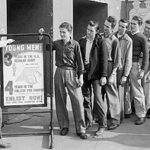
 in charge, and since the draft was discontinued, the number of people who chose to join up to serve their country and to qualify for the GI Bill so that they can get free college. No matter how they got in the service, or how long they stayed, I am very proud of all of our soldiers over the many years of this nation…and I thank them for their service. On this day, the largest army in history accepted the surrender of the Japanese, who had once had the nerve to attack us on our own soil. That was their biggest mistake ever.
in charge, and since the draft was discontinued, the number of people who chose to join up to serve their country and to qualify for the GI Bill so that they can get free college. No matter how they got in the service, or how long they stayed, I am very proud of all of our soldiers over the many years of this nation…and I thank them for their service. On this day, the largest army in history accepted the surrender of the Japanese, who had once had the nerve to attack us on our own soil. That was their biggest mistake ever.

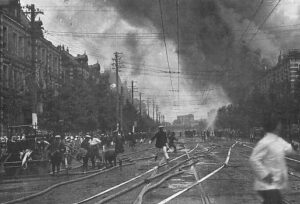 It was a typical lunch hour in Japan’s capital city of Tokyo, and the neighboring “City of Silk” Yokohama that September 1, 1923. People were out and about doing their normal lunchtime things, eating and running errands before going back to work. Suddenly the days routine was shattered when a massive, 7.9-magnitude earthquake struck just before noon. The shaking lasted just 14 seconds, but that was all it took to bring down nearly every building in Yokohama, which is just south of Tokyo. The shaking also caused more than half of Tokyo’s brick buildings, most of Yokohama’s buildings, and hundreds of thousands of homes to collapse, killing tens of thousands of people instantly.
It was a typical lunch hour in Japan’s capital city of Tokyo, and the neighboring “City of Silk” Yokohama that September 1, 1923. People were out and about doing their normal lunchtime things, eating and running errands before going back to work. Suddenly the days routine was shattered when a massive, 7.9-magnitude earthquake struck just before noon. The shaking lasted just 14 seconds, but that was all it took to bring down nearly every building in Yokohama, which is just south of Tokyo. The shaking also caused more than half of Tokyo’s brick buildings, most of Yokohama’s buildings, and hundreds of thousands of homes to collapse, killing tens of thousands of people instantly.
Known as the Great Kanto Earthquake, but also called the Tokyo-Yokohama Earthquake, of 1923, it caused an estimated death toll of more than 140,000 and left some 1.5 million people homeless, according to reported numbers. Following the earthquake came another disaster in the form of fires that burned many buildings. Most likely, this was because in 1923, people cooked over an open flame, and the quake struck while people were preparing lunch. To further complicate matters, the area was hit by high winds, caused by a typhoon that passed off the coast of the Noto Peninsula in northern Japan, spread the flames and created horrifying firestorms. Because the quake had snapped water mains, the fires could not be extinguished until September 3rd. By that time, about 45 percent of Tokyo had burned. Some researchers believed that the typhoon may have triggered the earthquake, because the forced atmospheric pressure pressed on a stressed and delicate fault line of three major tectonic plates that meet under Tokyo. I wasn’t aware that this was possible, but 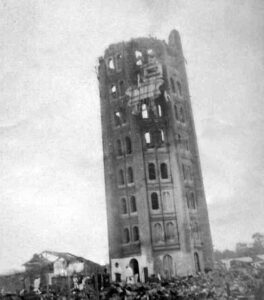 apparently it is. The quake also triggered a tsunami that swelled to 39.5 feet at Atami on the Sagami Gulf, where 60 people were killed and 155 homes destroyed.
apparently it is. The quake also triggered a tsunami that swelled to 39.5 feet at Atami on the Sagami Gulf, where 60 people were killed and 155 homes destroyed.
The damage from all this in Toyko was so severe that some government leaders argued for moving the Japanese capital to a new city. Educator, Miura Tosaku toured the destruction of Tokyo in the fall of 1923, concluded that the earthquake was an apocalyptic revelation. He wrote: “Disasters take away the falsehood and ostentation of human life and conspicuously expose the strengths and weaknesses of human society.” Tenrikyo relief worker Haruno Ki’ichi said, “The destruction and devastation in the earthquake aftermath surpassed imagination.”
Yokohama’s Victorian-era Grand Hotel, that had hosted famous people including US President William Howard Taft and English author Rudyard Kipling, completely collapsed. Hundreds of hotel employees and guests were crushed. Henry W Kinney, a Tokyo-based editor of the Trans-Pacific publication, observed the devastation in Yokohama hours after the earthquake hit. He wrote, “Yokohama, the city of almost half a million souls, had become a vast plain of fire, of red, devouring sheets of flame which played and flickered. Here and there a remnant of a building, a few shattered walls, stood up like rocks above the expanse of flame, unrecognizable … It was as if the very Earth were now burning. It presented exactly the aspect of a gigantic Christmas pudding over which the spirits were blazing, devouring nothing. For the city was gone.”
Since 1960, the Japanese people recognize the September 1 anniversary of the earthquake as Disaster Prevention Day. It’s a noble idea, but I’m not sure how these disasters could be prevented, other than the now common practice of earthquake proofing buildings to prevent so much loss. Nevertheless, Japan has suffered through several more devastating earthquakes. More than seven decades after the 1923 disaster, an earthquake struck Kobe on January 17, 1995. This Kobe Earthquake caused an estimated 6,400 deaths, widespread fires, and a landslide in Nishinomiya. Then, on March 11, 2011, a 9.0-magnitude temblor struck off th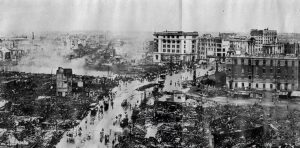
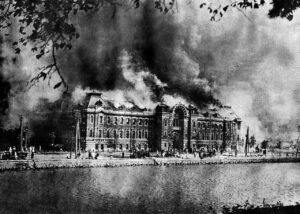 e coast of Japan’s city of Sendai. This Tohoku Earthquake and Tsunami caused a series of catastrophic tsunamis in Japan, and more than 18,000 estimated deaths. I suppose that to say the very least, the loss of life in these more recent quakes, was far less than in the original event that founded Disaster Prevent Day.
e coast of Japan’s city of Sendai. This Tohoku Earthquake and Tsunami caused a series of catastrophic tsunamis in Japan, and more than 18,000 estimated deaths. I suppose that to say the very least, the loss of life in these more recent quakes, was far less than in the original event that founded Disaster Prevent Day.
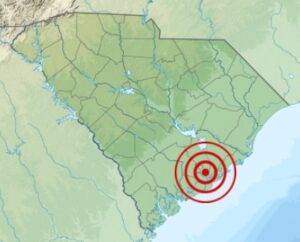
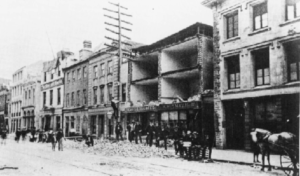 The shaking began at 9:51pm that August 31, 1886, and by the time it was over, more than 100 people in Charleston, South Carolina would be dead and hundreds of buildings were destroyed. It wasn’t that there were no warnings. There were…unheeded warnings in the form of two foreshocks that were felt in Summerville, South Carolina, on August 27th and 28th, but no one was prepared for the strength of the August 31 quake. The quake was felt as far away as Boston, Chicago, and even Cuba. Buildings were damaged as far away as Ohio and Alabama.
The shaking began at 9:51pm that August 31, 1886, and by the time it was over, more than 100 people in Charleston, South Carolina would be dead and hundreds of buildings were destroyed. It wasn’t that there were no warnings. There were…unheeded warnings in the form of two foreshocks that were felt in Summerville, South Carolina, on August 27th and 28th, but no one was prepared for the strength of the August 31 quake. The quake was felt as far away as Boston, Chicago, and even Cuba. Buildings were damaged as far away as Ohio and Alabama.
Even with all that, it was Charleston, South Carolina that took the biggest hit from the quake. While quake measurements in those days were not as accurate as they are these days, this quake was thought to measure a magnitude of about 7.6. Almost all of the buildings in Charleston were seriously damaged. Approximately 14,000 chimneys fell from the earthquake. Multiple fires erupted, and water lines and wells were ruptured. The total damage was in excess of $5.5 million in those days, which would figure to approximately $115 million today. The greatest damage was done to buildings constructed out of brick, which amounted to 81% of building damage. The frame buildings suffered significantly less damage. Another factor that came into play was kind of 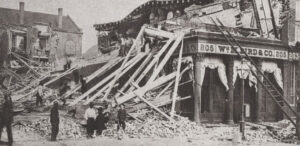 ground these buildings were built on. Buildings constructed on ground that had been built up to accommodate them (made ground), suffered significantly more damage than buildings constructed on solid ground, however, this relationship only occurred in wood-frame buildings. Approximately 14% of wood-frame buildings built on “made ground” sustaining damage, compared to 0.5% of wood-frame buildings built on solid ground sustaining damage.
ground these buildings were built on. Buildings constructed on ground that had been built up to accommodate them (made ground), suffered significantly more damage than buildings constructed on solid ground, however, this relationship only occurred in wood-frame buildings. Approximately 14% of wood-frame buildings built on “made ground” sustaining damage, compared to 0.5% of wood-frame buildings built on solid ground sustaining damage.
The residential buildings sustained significantly less damage than the more prominent commercial buildings, most of which were destroyed, or nearly so. This was due to the fact that commercial buildings were older, had a more prominent top compared to the base of the building, and were made of brick. The Old White Meeting House near Summerville, South Carolina was reduced to ruins. Many of the other man-made structures were also damaged as a result of earth splits caused by the earthquake. The railroad tracks in Charleston and nearby areas were snapped and trains were derailed. In addition, flooding occurred in surrounding farms and roads when dams broke. Acres of land actually liquefied in many spots, which further damaged many buildings, roads, bridges, and farm fields.
Strangely, for an earthquake of this magnitude anyway, was the fact that there were no apparent surface cracks as a result of this tremor, but railroad tracks were bent in all directions in some locations. The true cause of this quake remained a mystery for many years, because there were no known underground faults for 60 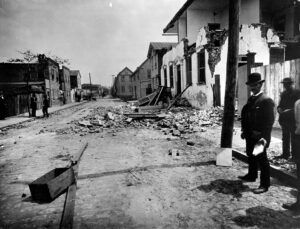
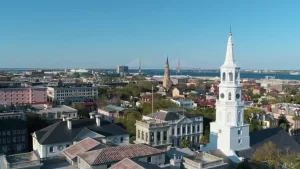 miles in any direction. However, now, with better science and detection methods, scientists have recently uncovered a “concealed fault” along the coastal plains of Virginia and the Carolinas. While there is now a known fault, a quake of this magnitude is highly unlikely in this location. Nevertheless, this was the largest recorded earthquake in the history of the southeastern United States.
miles in any direction. However, now, with better science and detection methods, scientists have recently uncovered a “concealed fault” along the coastal plains of Virginia and the Carolinas. While there is now a known fault, a quake of this magnitude is highly unlikely in this location. Nevertheless, this was the largest recorded earthquake in the history of the southeastern United States.
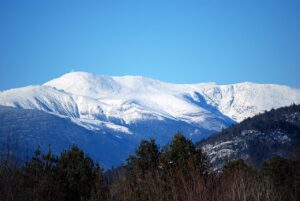
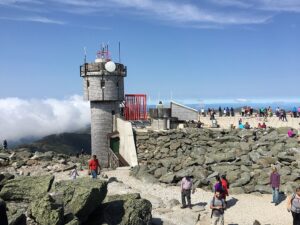 I have never been to the top of Mount Washington in New Hampshire, but I am intrigued by it, and by everything I have heard about it. Mount Washington is notorious for its erratic weather. On the afternoon of April 12, 1934, the Mount Washington Observatory recorded a windspeed of 231 miles per hour at the summit, the world record from 1934 until 1996. Mount Washington still holds the record for highest measured wind speed not associated with a tornado or tropical cyclone. Can you just imagine trying to stand outside in that wind? I can’t imagine trying to stand out in that wind, especially in winter, but I can imagine seeing that place…maybe not on a really windy day, but just to see the top would be very cool.
I have never been to the top of Mount Washington in New Hampshire, but I am intrigued by it, and by everything I have heard about it. Mount Washington is notorious for its erratic weather. On the afternoon of April 12, 1934, the Mount Washington Observatory recorded a windspeed of 231 miles per hour at the summit, the world record from 1934 until 1996. Mount Washington still holds the record for highest measured wind speed not associated with a tornado or tropical cyclone. Can you just imagine trying to stand outside in that wind? I can’t imagine trying to stand out in that wind, especially in winter, but I can imagine seeing that place…maybe not on a really windy day, but just to see the top would be very cool.
There are basically three ways to get to the top of Mount Washington. The first is to drive up on the Mount Washington Auto Road. If you choose this one, you can get one of the This Car Climbed Mount Washington 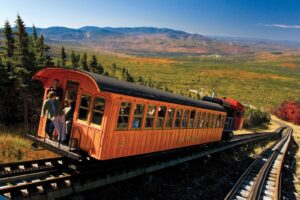 bumper stickers that are common throughout New England following your trip up the mountain, but to me that rather defeats the purpose reaching the summit. Now, if a person is an experienced hiker, there is a hiking trail to the top. And if you are really fanatical, you can hike it in Winter, taking the Snow Coach halfway up. Now, I like to hike, but definitely not in the Winter. One of the shortest, most scenic, and most popular trails to the summit is the 4.2-mile class 2 Tuckerman Ravine Trail that starts at the AMC Pinkham Notch Visitor Center (2050′). While 4.2 miles is doable, the class 2 part, meaning “more difficult hiking that may be off-trail. You may also have to put your hands down occasionally to keep your balance. May include easy snow climbs or hiking on talus/scree. Class 2 includes a wide range of hiking, and a route may have exposure, loose rock, steep scree, etc” is a little more off-putting for me.
bumper stickers that are common throughout New England following your trip up the mountain, but to me that rather defeats the purpose reaching the summit. Now, if a person is an experienced hiker, there is a hiking trail to the top. And if you are really fanatical, you can hike it in Winter, taking the Snow Coach halfway up. Now, I like to hike, but definitely not in the Winter. One of the shortest, most scenic, and most popular trails to the summit is the 4.2-mile class 2 Tuckerman Ravine Trail that starts at the AMC Pinkham Notch Visitor Center (2050′). While 4.2 miles is doable, the class 2 part, meaning “more difficult hiking that may be off-trail. You may also have to put your hands down occasionally to keep your balance. May include easy snow climbs or hiking on talus/scree. Class 2 includes a wide range of hiking, and a route may have exposure, loose rock, steep scree, etc” is a little more off-putting for me.
That leaves the final, and for me, most intriguing way to make the summit…the Mount Washington Cog Railway. While the other ways to reach the summit are very cool, the Cog is special!! This is basically a mountain climbing train. It’s a unique journey that is as much of a fun retro adventure as it is an impressive engineering 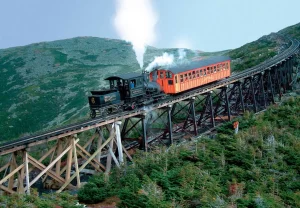
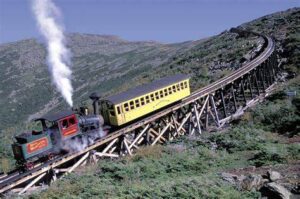 marvel. The track of the Cog Railway is approximately 3 miles long, and it ascends up Mount Washington’s western slope, beginning at an elevation of approximately 2,700 feet above sea level and ending just short of the mountain’s summit peak of 6,288 feet. The Cog is the second-steepest rack railway in the world to this day. It is second only to the Pitalus Railway in Switzerland.
marvel. The track of the Cog Railway is approximately 3 miles long, and it ascends up Mount Washington’s western slope, beginning at an elevation of approximately 2,700 feet above sea level and ending just short of the mountain’s summit peak of 6,288 feet. The Cog is the second-steepest rack railway in the world to this day. It is second only to the Pitalus Railway in Switzerland.

 My niece, Lindsay Hadlock has always been a strong Christian, but over the years, she has flourished and is now working in leadership positions within the faith too. We are all very proud of her in her endeavors. In late 2022, Lindsay felt led to start a Christian podcast called “The New Way To Live” and it is going so well. Her first podcast was on November 20, 2022, and I would encourage everyone to check it out. Lindsay’s faith is strong, and you can always tell how strongly the Holy Spirit guides her with her messages. Lindsay loves her church family too.
My niece, Lindsay Hadlock has always been a strong Christian, but over the years, she has flourished and is now working in leadership positions within the faith too. We are all very proud of her in her endeavors. In late 2022, Lindsay felt led to start a Christian podcast called “The New Way To Live” and it is going so well. Her first podcast was on November 20, 2022, and I would encourage everyone to check it out. Lindsay’s faith is strong, and you can always tell how strongly the Holy Spirit guides her with her messages. Lindsay loves her church family too.
She and her family have been attending Harvest Church since they moved to Laramie, Wyoming for her husband, Shannon Moore’s job as assistant coach and tight ends coach and helps with special teams for the Wyoming Cowboys football team. Their membership at Harvest Church has been a great blessing to them. Lindsay has helped with the Women’s Conference there, the Vacation Bible School, and their Communion services. She is also on the church council. She has also started holding a Bible study in her home. That has 
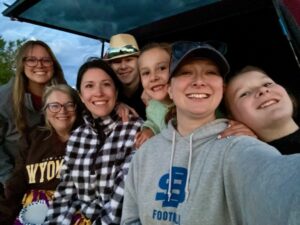 been a great blessing to all who attend. Lindsay also attends a Bible study for (Fellowship of Christian Athletes) FCA. She loves the Lord, loves her church, and really loves living in Laramie. She has flourished there and has many friends. Lindsay makes friends so easily, so that is not even a surprise. Shannon, and their daughter, Mackenzie decorated the house for her this morning as a birthday surprise. I’m sure her Bible study group really enjoyed that.
been a great blessing to all who attend. Lindsay also attends a Bible study for (Fellowship of Christian Athletes) FCA. She loves the Lord, loves her church, and really loves living in Laramie. She has flourished there and has many friends. Lindsay makes friends so easily, so that is not even a surprise. Shannon, and their daughter, Mackenzie decorated the house for her this morning as a birthday surprise. I’m sure her Bible study group really enjoyed that.
As usual, Lindsay, Shannon, and Mackenzie usually do a lot of traveling during the summer, before Shannon goes back to work, and some for games and such during the year too. Hiking is always a part of their travels. This year they went out to Minnesota for a wedding and visited some friends there and in the Brookings, South Dakota area. They showed Mackenzie where Shannon used to live and gave her a tour of South Dakota State University. They went to Houston over spring break and had a great time seeing the sights and the beach. Lindsay works for South Dakota State 
 University as the director of HOP…the Health and Obesity Program. She’s been very busy at work and had also traveled a couple of times for work up to South Dakota to do sight visits and for a conference. She is usually a speaker at the conference and does a great job presenting. She also went to Atlanta for a work conference and spoke at that one as well. Lindsay leads a very busy life. Today is Lindsay’s birthday. Happy birthday Lindsay!! Have a great day!! We love you!!
University as the director of HOP…the Health and Obesity Program. She’s been very busy at work and had also traveled a couple of times for work up to South Dakota to do sight visits and for a conference. She is usually a speaker at the conference and does a great job presenting. She also went to Atlanta for a work conference and spoke at that one as well. Lindsay leads a very busy life. Today is Lindsay’s birthday. Happy birthday Lindsay!! Have a great day!! We love you!!
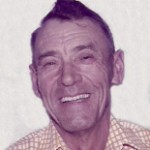
 I always thought of my father-in-law, Walt Schulenberg as a workaholoc, and in reality, he was, but he was also a man who lived life to the fullest. Over the span of his life, he held many jobs…some of which he liked better than others. Nevertheless, no matter what he was doing for a living, he always worked hard, made his boss and his family proud, and worked with a smile on his fact. He was a very good-natured person, and that always showed in his everyday life.
I always thought of my father-in-law, Walt Schulenberg as a workaholoc, and in reality, he was, but he was also a man who lived life to the fullest. Over the span of his life, he held many jobs…some of which he liked better than others. Nevertheless, no matter what he was doing for a living, he always worked hard, made his boss and his family proud, and worked with a smile on his fact. He was a very good-natured person, and that always showed in his everyday life.
People loved my father-in-law, and in fact, I never heard anyone say anything against him. He had many friends from work; craft fairs he and my mother-in-law, Joann did; and from his work remaking lawn chairs, whirligigs, toys, and other things he sold from the front porch of his house. He really never met a stranger. Every new person he 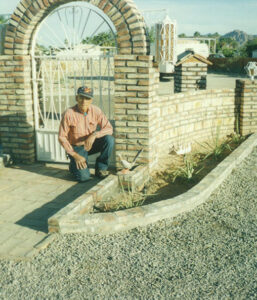
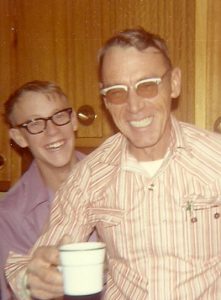 met became an instant friend. His great sense of humor made him so easy to get to know, and immediately like.
met became an instant friend. His great sense of humor made him so easy to get to know, and immediately like.
One of the jobs that he especially loved was driving the bus for the Casper College T-Birds athletic teams. That job allowed him to travel and get to know they young people he transported. They loved him, and he loved them. It was a win-win situation. Of course, that meant he was occasionally away from my mother-in-law, but they had been married for many years by then, and had grown kids who could check in on her, to see if she needed anything. She didn’t really like traveling as much as he did anyway, so she was ok with that, and he got to travel.
In their later years, they used to spend winters in Yuma, Arizona. It was really the one kind of traveling my mother-in-law didn’t mind too much, at least not once the packing and unpacking of the trailer were finished. The were members of the Good Sam’s Camping Club, and so there were gatherings, and such to enjoy down 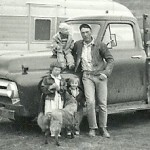
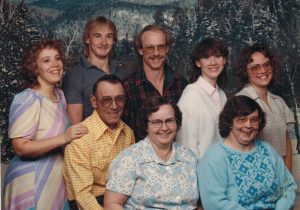 there too. My father-in-law really enjoyed the time down there. He found people who needed some odd job done, because he just couldn’t stand to sit around and watch my mother-in-law crochet. Not that he didn’t want to spend time with her, but let’s face it, watching someone else crochet is a great way to fall asleep. He was never one to sit around and watch the “paint dry” anyway. Today would have been my father-in-law’s 95th birthday. Happy birthday in Heaven, Dad. We love and miss you very much.
there too. My father-in-law really enjoyed the time down there. He found people who needed some odd job done, because he just couldn’t stand to sit around and watch my mother-in-law crochet. Not that he didn’t want to spend time with her, but let’s face it, watching someone else crochet is a great way to fall asleep. He was never one to sit around and watch the “paint dry” anyway. Today would have been my father-in-law’s 95th birthday. Happy birthday in Heaven, Dad. We love and miss you very much.
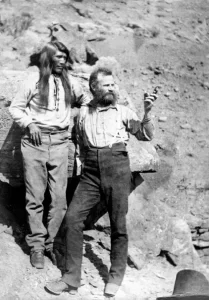
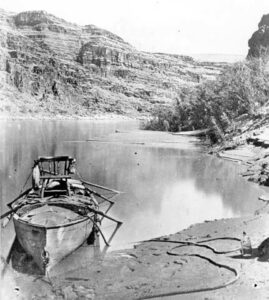 When John Wesley Powell began his expedition through the Grand Canyon he took eleven men with him. The plan was to explore the Grand Canyon by boat. Powell was a one-armed Civil War veteran and self-trained naturalist. The men had been on their expedition for about three months, when three of the men became very concerned about the safety of the mission. Some of the rapids had been heavy, and just ahead, they could hear what the worst of the rapids. The three men, terrified of the rapids that lay ahead, were convinced that they would have a better chance of survival, if they scaled the steep cliffs to the plateau above and walked out.
When John Wesley Powell began his expedition through the Grand Canyon he took eleven men with him. The plan was to explore the Grand Canyon by boat. Powell was a one-armed Civil War veteran and self-trained naturalist. The men had been on their expedition for about three months, when three of the men became very concerned about the safety of the mission. Some of the rapids had been heavy, and just ahead, they could hear what the worst of the rapids. The three men, terrified of the rapids that lay ahead, were convinced that they would have a better chance of survival, if they scaled the steep cliffs to the plateau above and walked out.
It would be hard to fault the men. When the party heard the rapids, they pulled to shore and walked down to see what lay ahead. Indeed, the worst was yet to come. Upon reaching the site of the rapids on foot, they saw, in the words of one man, “the worst rapids yet.” There was no argument from Powell, who wrote that, “The billows are huge, and I fear our boats could not ride them… There is discontent in the camp tonight, and I fear some of the party will take to the mountains but hope not.”
Indeed, the three men decided that they were not going to risk the rapids, so they scaled the cliffs…a move 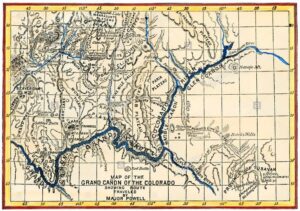 that turned out to be not only a serious mistake but a fatal one. It wasn’t their fault really. They truly thought that Powell’s plan to float the brutal rapids was suicidal. The men were convinced that Powell’s four wooden boats would have been smashed to bits in the punishing rapids…the kind that many would hesitate to run even with modern rafts.
that turned out to be not only a serious mistake but a fatal one. It wasn’t their fault really. They truly thought that Powell’s plan to float the brutal rapids was suicidal. The men were convinced that Powell’s four wooden boats would have been smashed to bits in the punishing rapids…the kind that many would hesitate to run even with modern rafts.
The next day, three of Powell’s men did leave. Convinced that the rapids were impassable, they decided to take their chances crossing the harsh desert lands above the canyon rims. So, on August 28, 1869, Seneca Howland, O G Howland, and William H Dunn said goodbye to Powell and the other men and began the long climb up out of the Grand Canyon. Once the three men left, the rest of the party steeled themselves to the ordeal that lay ahead, climbed into boats, and pushed off into the wild rapids.
While it seemed like a suicide mission, all of men survived the rapids, and the expedition emerged from the canyon the next day. Sadly, when he reached the nearest settlement, Powell learned that the three men who left had not been for fortunate. Allegedly, they encountered a war party of Shivwit Native Americans, and all 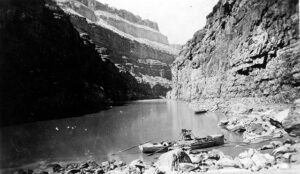
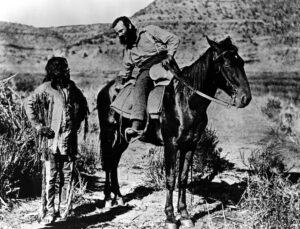 three were killed. Ironically, the three murders were initially viewed as more newsworthy than Powell’s amazing feat and the expedition gained valuable publicity. When Powell planned a second trip through the Grand Canyon in 1871, the publicity from the first trip insured that the second voyage was far better financed than the first. Sadly, the increased financing for the expedition came at great cost…to the three men who were murdered anyway.
three were killed. Ironically, the three murders were initially viewed as more newsworthy than Powell’s amazing feat and the expedition gained valuable publicity. When Powell planned a second trip through the Grand Canyon in 1871, the publicity from the first trip insured that the second voyage was far better financed than the first. Sadly, the increased financing for the expedition came at great cost…to the three men who were murdered anyway.

 My grandniece, Aurora Hadlock started 8th grade yesterday. I keep asking myself, “How can that be?” She was just a baby the day before that, wasn’t she? No, of course, she wasn’t, but time certainly flies. She has grown into a beautiful young lady, who is definitely her mother, Chelsea Hadlock’s mini-me! Aurora is also in her second year of volleyball and totally loves it, despite the fact that practice is before school every day at 6am!! Now that’s dedication. This past weekend, she got to go to a comic con, so she could see the guys from Twilight. She loved walking around dressed up as Max from Stranger Things and buying art and Funko Pops. Still, Aurora’s favorite thing is reading and learning. She can always be found with a few books in her bag, just in case there is a moment to read.
My grandniece, Aurora Hadlock started 8th grade yesterday. I keep asking myself, “How can that be?” She was just a baby the day before that, wasn’t she? No, of course, she wasn’t, but time certainly flies. She has grown into a beautiful young lady, who is definitely her mother, Chelsea Hadlock’s mini-me! Aurora is also in her second year of volleyball and totally loves it, despite the fact that practice is before school every day at 6am!! Now that’s dedication. This past weekend, she got to go to a comic con, so she could see the guys from Twilight. She loved walking around dressed up as Max from Stranger Things and buying art and Funko Pops. Still, Aurora’s favorite thing is reading and learning. She can always be found with a few books in her bag, just in case there is a moment to read.
Aurora has her own style. She is funny, clever, weird (and proud of it!), kind, compassionate, and encouraging. Her carefree style and the ease with which she communicates with people has made her a lot of friends, all of whom she calls her “bestie”, including her grandpa, Chris Hadlock!! She’s really finding her own way, with fashion and everything else, as she is quickly becoming a young woman. I love that she is following her own heart in all things, and not being just led along by what others think is style. She may like some things others do, but only if it suits her. She is her own girl. Full of confidence and spunk!! That’s as it should be.
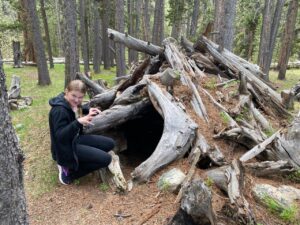

Aurora has a sweet heart, and she is very good with her cousins, Adelaide, Mackenzie and Jolene. They absolutely love to play with Aurora!! She never acts like they are in the way, or that their games are beneath her. Rare qualities in a teenager. They all ask if she will be there every time the family all gets together…and I’m sure she will do her best to do so. She is definitely someone they all look up to!! She is such a sweetheart!!
When I asked about story ideas for Aurora, her aunt, Lindsay Moore said, “Oh you mean, Caroline?” Lindsay then went on to say, “Aurora is such a fun character and she has perfected her southern accent! We love Aurora. She is a kind and sweet girl! She is quickly growing up, but I still want to hold her like a little teeny tiny baby! She is a kind and sweet girl!!” I think that most of us feel the very same way.
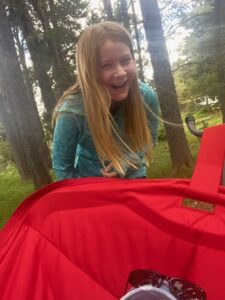

The “Caroline” part intrigued me, so I asked about it. Lindsay told me, “It’s her southern name!! Lindsay said, “Aurora is Caroline, and they named Mackenzie (Lindsay’s daughter) Savannah when we were camping together.” The story goes like this according to Chelsea, “In 5th grade, Aurora’s teacher gave the class “southern names” because she was from the south and they thought it was funny. Aurora’s southern name was Caroline, and since then she will occasionally put on a southern accent and call herself Caroline. She’s so funny.” Well, there you have it Aurora is also “Caroline” and has perfected her southern accent too!! Today, Aurora is a teenager. Happy 13th birthday Aurora!! Have a great day!! We love you!!

